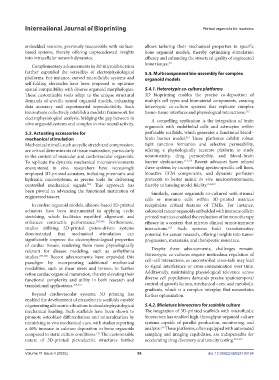Page 94 - v11i4
P. 94
International Journal of Bioprinting Printed organoids for medicine
embedded neurons, previously inaccessible with surface- allows tailoring their mechanical properties to specific
based systems, thereby offering unprecedented insights bone organoid models, thereby optimizing stimulation
into intracellular network dynamics. efficacy and enhancing the structural quality of engineered
Complementary advancements in 3D microfabrication bone tissues. 211
further expanded the versatility of electrophysiological 5.4. Multicomponent bio-assembly for complex
platforms. For instance, curved microfluidic systems and organoid models
self-folding electrodes have been proposed to optimize
spatial compatibility with diverse organoid morphologies. 5.4.1. Heterotypic co-culture platforms
These customizable tools adapt to the unique structural 3D bioprinting enables the precise co-deposition of
demands of specific neural organoid models, enhancing multiple cell types and biomaterial components, creating
data accuracy and experimental reproducibility. Such heterotypic co-culture systems that replicate complex
innovations collectively establish a modular framework for tissue–tissue interfaces and physiological interactions.
212
electrophysiological analysis, bridging the gap between in A compelling application is the integration of brain
vitro organoid systems and complex in vivo neural activity.
organoids with endothelial cells and astrocytes within
5.3. Actuating accessories for perfusable scaffolds, which generates a functional blood–
213
mechanical stimulation brain barrier model. These platforms exhibit robust
Mechanical stimuli, such as cyclic stretch and compression, tight junction formation and selective permeability,
are critical determinants of tissue maturation, particularly offering a physiologically accurate platform to study
in the context of muscular and cardiovascular organoids. neurotoxicity, drug permeability, and blood–brain
To replicate the dynamic mechanical microenvironments barrier dysfunction. 214,215 Recent advances have refined
encountered in vivo, researchers have increasingly these systems by incorporating species-specific cell lines,
employed 3D-printed actuators, including pneumatic and bioactive ECM components, and dynamic perfusion
hydraulic microsystems, as precise tools for delivering protocols to better mimic in vivo microenvironments,
controlled mechanical signals. This approach has thereby enhancing model fidelity. 216,217
205
been pivotal in advancing the functional maturation of Similarly, cancer organoids co-cultured with stromal
engineered tissues.
cells or immune cells within 3D-printed matrices
In cardiac organoid models, silicone-based 3D-printed recapitulate critical features of TMEs. For instance,
actuators have been instrumental in applying cyclic colorectal cancer organoids embedded with immune cells in
stretching, which facilitates myofibril alignment and printed matrices enabled the evaluation of immunotherapy
enhances contractile performance. 205,206 Furthermore, efficacy in a context that mirrors clinical tumor-immune
studies utilizing 3D-printed piston-driven systems interactions. Such systems hold transformative
213
demonstrated that mechanical stimulation can potential for cancer research, offering insights into tumor
significantly improve the electrophysiological properties progression, metastasis, and therapeutic resistance.
of cardiac tissues, rendering them more physiologically
relevant for disease modeling, such as arrhythmia Despite these advancements, challenges remain.
studies. 207,208 Recent advancements have expanded this Heterotypic co-cultures require meticulous regulation of
paradigm by incorporating additional mechanical cell–cell interactions, as uncontrolled cross-talk may lead
modalities, such as shear stress and torsion, to further to signal interference or cross-contamination over time.
refine cardiac organoid maturation, thereby elevating their Additionally, maintaining physiological relevance across
functional complexity and utility in both research and diverse cell populations demands precise spatiotemporal
translational applications. 209,210 control of growth factors, mechanical cues, and metabolic
gradients, which is a complex interplay that necessitates
Beyond cardiovascular systems, 3D printing has further optimization.
enabled the development of piezoelectric scaffolds capable
of generating ultrasonic vibrations to simulate physiological 5.4.2. Miniature bioreactors for scalable culture
mechanical loading. Such scaffolds have been shown to The integration of 3D-printed scaffolds with microfluidic
promote osteoblast differentiation and mineralization by bioreactors has enabled high-throughput organoid culture
mimicking in vivo mechanical cues, with studies reporting systems capable of parallel production, monitoring, and
218
a 40% increase in calcium deposition in bone organoids analysis. These platforms, often equipped with automated
compared to static culture conditions. The customizable sampling and imaging capabilities, are indispensable for
121
nature of 3D-printed piezoelectric structures further accelerating drug discovery and toxicity testing. 201,219
Volume 11 Issue 4 (2025) 86 doi: 10.36922/IJB025190184

